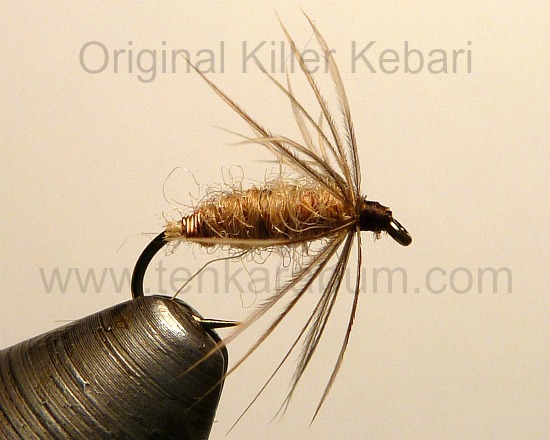Trip Report 11-29-20
Tenkara Fishing with North Country Spiders
First, a bit of background information. The path that eventually led me to discovering tenkara started with a photo of a North Country Spider. The simple, slim body and the ultra sparse hackle that looked for all the world like the ribs of a super small umbrella were magical, and I am still under their spell.
North Country Spiders are also called North Country Wet Flies, or North Country Wets, and some just call them soft hackles, but the term soft hackles refers to many, many more patterns than the slim, sparse flies that are understood to be North Country Spiders.
Early in my tenkara journey, though, I fell into the "tenkara flies are sakasa kebari" trap, so nearly all my photos show flies with forward slanting hackle. I also fell into the Killer Bug trap because it is just so effective where I normally fish.
Henry David Thoreau, who famously spent two years in a small cabin he built on Walden Pond in Massachusetts, wrote "Many men go fishing all of their lives without knowing that it is not fish they are after." Christopher Thomas Knight, aka The North Pond Hermit, who spent 27 years living undetected in a crude camp he built near North Pond in Maine said Thoreau was a "dilletante." When I go fishing, I go to catch fish -- and Killer Bugs catch fish.
Combining the hackle of a North Country Spider with the body of a Killer Bug produces a Killer Kebari.
I now post only the photo that has the watermark because over the years I have seen photos of so many flies labelled Killer Kebari that look absolutely nothing like the original. It is a little disheartening. (For that very same reason, I have rewritten the step-by-step instructions I had posted for the Ishigaki Kebari because what had been on that page looked absolutely nothing like the original. I am sure I will revise it again if I can tie a fly that more closely resembles Dr. Ishigaki's own creations.)
Of course, a connoisseur of North Country Spiders would say (quite correctly) that my Killer Kebari looks absolutely nothing like a North Country Spider. Touché.
It does catch fish, though!
I'll have to tie some with no wire and only one layer of yarn. I think they'd turn out thin enough to fit the profile, and I think they would be about as effective as the Killer Kebari.
Enough with the background information! After experimenting the last couple trips with ultra-light lines to fish micro nymphs, the purpose of this trip was to see if a North Country Spider, which offers virtually no resistance to being pulled through the water by line sag, could be fished effectively with a size 1.5 or size 2 line.
My experiment faced two significant hurdles: 1) It was late November and I never do well fishing in the winter, and 2) It was a very nice day for late November and the stream (which is the only even reasonably good trout stream in southern New York that is open for fishing in late November) was packed. Before I had a chance at it, I saw three other anglers fish the one stretch on the stream in which I usually do best. In other words, I got skunked.
I did hook one fish (in my fourth favorite spot). In savoring the fight, I did not land the fish at the earliest possible moment. The fish then got under a log, where it was able to dislodge the hook.
On other trips and in other locales I have caught fish while tenkara fishing using extremely sparse flies - and with lines heavier than 1.5 and 2. Three flies in particular stand out.
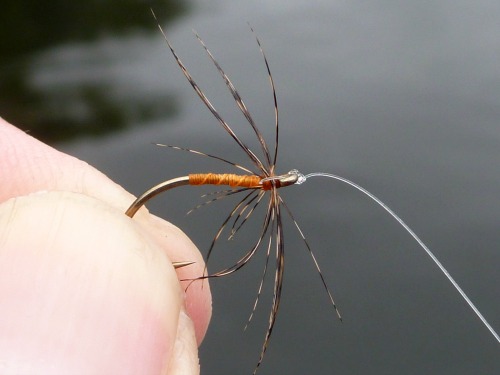 Partridge and Orange, tied in hand.
Partridge and Orange, tied in hand.One was a fly I tied on my Maine vacation when I was running the No Vise challenge for tying flies in hand. It wasn't beautiful, but it was very sparse and it did catch fish. On the other hand, it was fished in still water and I always pull my flies when fishing still water. Thus, line sag was irrelevant.
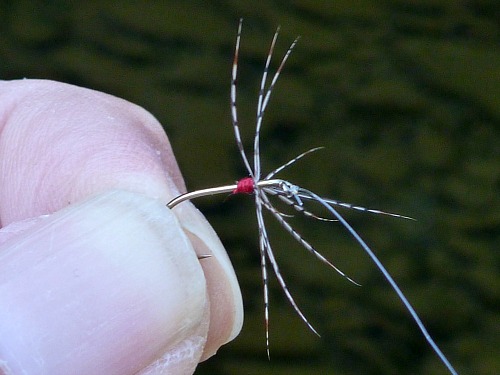 "Red Spot"
"Red Spot"The second was a fly tied when I was playing around with how little I could tie on a hook and still catch fish. I was able to catch fish with that fly, so the answer is "very little."
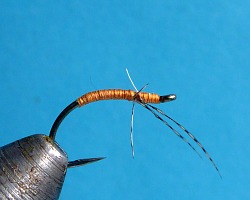
And the third? Well the third proves that well-chewed flies can still
produce! I was still catching fish with this fly when I took it off the
line because I didn't want to lose it. I definitely wanted to get it
home so I could get a good photo. It started out sparse, but it wasn't anywhere near that sparse!
I did not keep notes, but I would bet that all three of those flies were
fished with a size 3 line when I caught fish with them. I think the red
one, which was fished in a stream, would have been a bit more effective
if fished with a size 1.5 or 2 line. It did catch fish, though, so the heavier line must not have been that much of a problem.
On this trip, after cycling
through a number of flies that could reasonably be called "in the North
Country style" with nary a tap, I tied on a fly that was another of the flies I had tied to see how little I could tie on a hook and still hook fish.
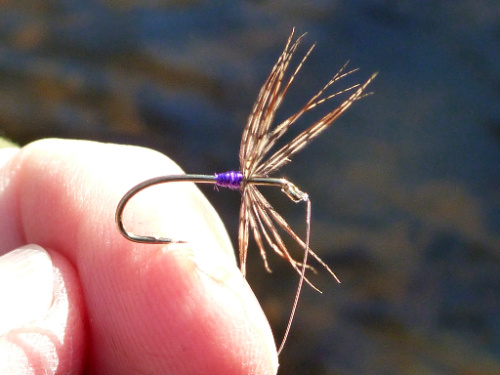 They say purple is a good color in winter.
They say purple is a good color in winter.It's not quite as sparse as the red one above, but it is the fly with which I hooked the only fish on this trip. Fished with a size 2 line on a very soft rod (Nissin Pro Square Level Line 390), it cast well and must not have had too much drag caused by line sag.
A couple years ago, I essentially gave up fishing flies that didn't provide much resistance to being pulled through the water. I now think that wasn't necessary. Over the years I have caught lots and lots of fish with Killer Bugs. I've caught lots of micros with size 20 bead head Killer Buggers, and more than a few with size 26 bead head Killer Buggers - which truly provide no resistance to being pulled through the water.
I am still drawn to North Country Spiders. I have not fished them much with tenkara rods, as I had gotten side-tracked with sakasa kabari and Killer Bugs. I had also fallen into the trap of thinking they are not proper tenkara flies, somehow forgetting that they were originally developed when people fished long rods with horsehair lines tied to the rod tip. I suspect I will fish them more next year, very likely with a horsehair line tied to my rod tip.
Home > Tenkara Trip Reports > Trip Report 11-29-20
Home > Hair-Brained > Trip Report 11-29-20
“The bitterness of poor quality remains long after the sweetness of low price is forgotten” - Benjamin Franklin
"Be sure in casting, that your fly fall first into the water, for if the line fall first, it scares or frightens the fish..." -
Col. Robert Venables 1662
As age slows my pace, I will become more like the heron.
We've all had situations where seriously chewed up flies kept catching fish after fish after fish. It is no sin to tie flies that come off the vise looking seriously chewed up.
Warning:
The hooks are sharp.
The coffee's hot.
The fish are slippery when wet.
Beware of the Dogma
Seriously, all the hooks sold on TenkaraBum.com, whether packaged as loose hooks or incorporated into flies, are dangerously sharp. Some have barbs, which make removal from skin, eyes or clothing difficult. Wear eye protection. Wear a broad-brimmed hat. If you fish with or around children, bend down all hook barbs and make sure the children wear eye protection and broad-brimmed hats. Be aware of your back cast so no one gets hooked.
Also, all the rods sold on TenkaraBum.com will conduct electricity. Do not, under any circumstances, fish during a thunder storm. Consider any fishing rod to be a lightning rod! Fishing rods can and do get hit by lightning!
What's in stock?
Suntech Tenkarakyo 40F Tenkara Rods
Daiwa Keiryu-X 39
Nissin Oni Tenkara Line
Coming Soon
January
Kurenai II AR 30F
Kurenai II AR 33F
Kurenai II AR 39F
Nissin Oni Line size 3
Nissin Oni Line size 3.5
TenkaraBum 33
TenkaraBum 36
TenkaraBum 40
Medium Rod Case
Furaibo TF39
Furaibo TF39TA
Latest Pages
I enjoyed your article about North Country flies. This last year I have been thoroughly obsessed with sparsely tied soft hackles. I didn’t experience the same “tenkara fly” contradiction and I’m glad I didn’t.
They have worked extremely well for me in smaller streams and I absolutely love tying them. There is something about the elegance and simplicity that I find completely mesmerizing....not to mention they are fast ties and fill up a box quickly.
I have had great success fishing with them in a typical upstream tenkara fashion, but when I finish with the dead drifts and manipulations, or when I just get sloppy and tired heading back downstream to the car, I like casting them quartering downstream in a simple wet fly swing, keeping a high rod tip to raise the hi vis line off the water and to allow a good rod bend after the strike.
It has turned out to be VERY effective and exciting for me. Perhaps I don’t always fish thoroughly enough on the way up, but I usually end up picking up numerous “bonus” fish. The takes are much more exciting to me, as well. Even a juvenile fish will leave me grinning ear to ear.
Kris F, Montana
If you enjoy spin fishing or baitcasting please visit my sister site Finesse-Fishing.com.
